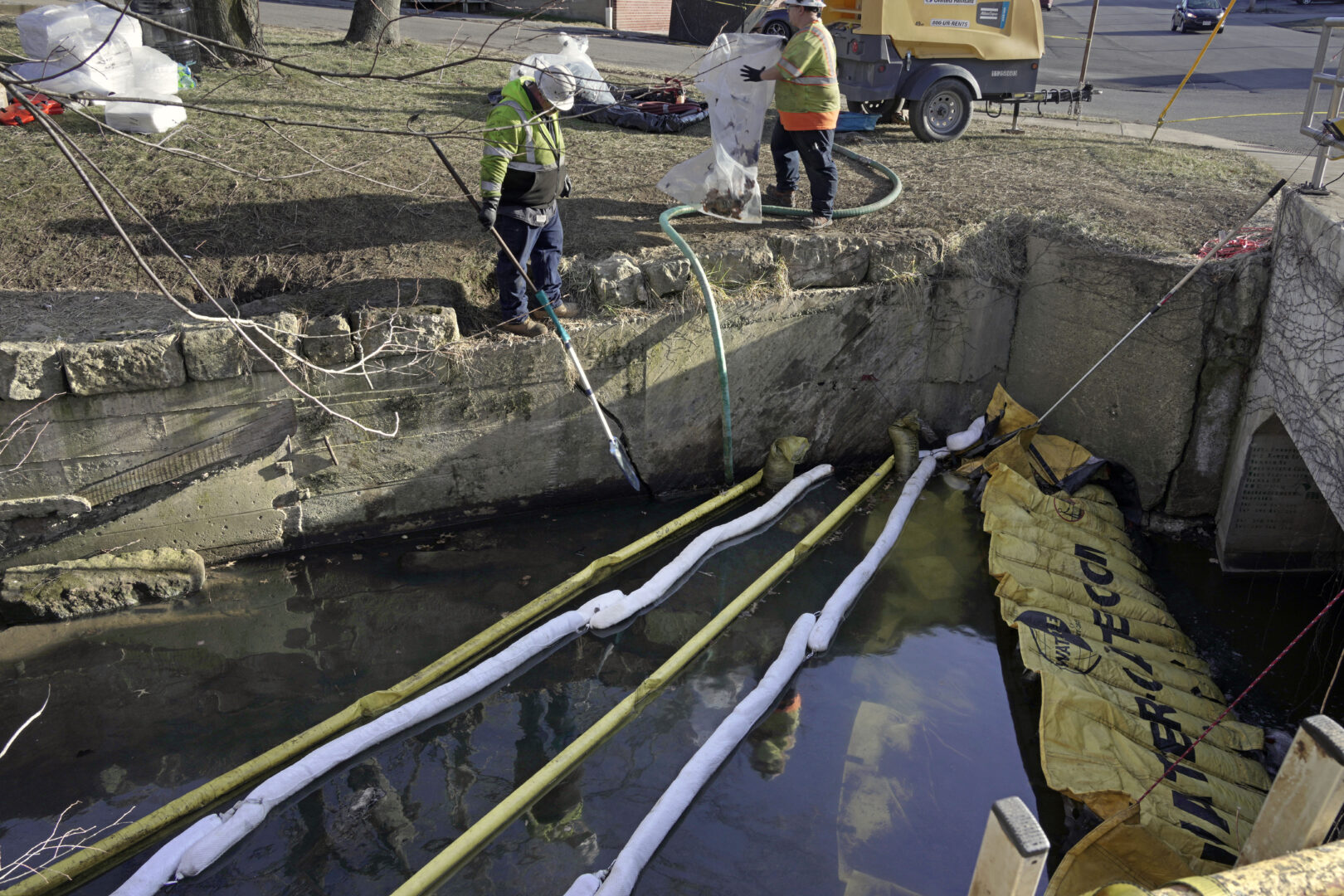
Booms are placed in a stream that flows through the center of East Palestine, Ohio, Wednesday, Feb. 15, 2023, as cleanup continues following the derailment of a Norfolk Southern freight train over a week ago.
Gene J. Puskar / AP Photo

Booms are placed in a stream that flows through the center of East Palestine, Ohio, Wednesday, Feb. 15, 2023, as cleanup continues following the derailment of a Norfolk Southern freight train over a week ago.
Gene J. Puskar / AP Photo

Gene J. Puskar / AP Photo
Booms are placed in a stream that flows through the center of East Palestine, Ohio, Wednesday, Feb. 15, 2023, as cleanup continues following the derailment of a Norfolk Southern freight train over a week ago.
The federal Occupational Safety and Health Administration is investigating Norfolk Southern and one of its contractors over working conditions in the aftermath of the Feb. 3 derailment in East Palestine, Ohio.
“OSHA has opened investigations with Norfolk Southern and Hepaco,” Scott Allen, a spokesman for OSHA, said in an email. He said the agency has six months to complete its investigation.
The union that represents Norfolk Southern workers brought in to clear and rebuild the tracks in the hours and days after the derailment says many workers are now complaining of health effects similar to those experienced by residents of East Palestine.
“We have members experiencing nausea, headaches, eye and throat irritation, skin rashes and respiratory problems,” said Johnny Long, general chairman of the American Rail System Federation, which represents some of the Norfolk Southern employees who were called to the scene after the derailment.
On the night of Feb. 3, 38 cars of a Norfolk Southern train derailed, including 11 that were carrying hazardous materials. Five of those cars carried vinyl chloride, a highly flammable, highly toxic chemical used in plastics manufacturing. Other cars contained butyl acrylate, which can irritate the skin, eyes and lungs, and cause headaches and dizziness, ethylhexyl acrylate, which can cause burning on the skin and in the eyes, coughing and shortness of breath; isobutylene, which can make people dizzy and drowsy; and ethylene glycol monobutyl ether which can cause coughing, dizziness, drowsiness, headaches, nausea, and weakness if inhaled.
Over the following weekend, workers went to the site to clear and repair the tracks. While residents within a 1-mile radius were told to evacuate, workers were sent to the site to clear damaged track, excavate and repair the ground, and put in new temporary track.
“If you’re telling the whole community to evacuate, and then you’re having [workers] right there at the derailment site,” Long said. “Those things just don’t add up to me.”
Long said workers were given minimal information about the chemicals they would be working around and almost no hazardous material protective gear.
“They were not briefed on the chemicals that they were going to be around. They were told, however, that the air quality was safe,” Long said. “They weren’t provided with any other [protective equipment] other than an N-95 face mask, which they were also told it wasn’t necessary to wear it, but they could wear it if they wanted to.”
On Feb. 6, Norfolk Southern made the decision to burn off the vinyl chloride rather than risk a “catastrophic” explosion, sending a black plume into the sky.
Connor Spielmaker, a spokesman for Norfolk Southern, said in an email that the company coordinated its response to the derailment “with hazardous material professionals who were on site continuously to ensure the work area was safe to enter and the required PPE was utilized, all in addition to air monitoring that was established within an hour” of the crash.
“We received no reports of illness from any of our crew members who were working on the remediation site. We continue to work with all agencies on their investigations,” Spielmaker said.
Calls to HEPACO, a national hazardous materials contractor, were not returned.
Long said the workers were worried about what effects breathing in chemicals near the site would have on them.
“They’re worried,” he said. “They don’t really know what to expect. I mean, I’ve been asked many times, ‘What do we need to be looking out for? What can these chemicals do to us now and in long term?,’ and I just don’t have those answers.”
Allen, the OSHA spokesman, said the agency has six months to complete its investigation.

A collection of interviews, photos, and music videos, featuring local musicians who have stopped by the WITF performance studio to share a little discussion and sound. Produced by WITF’s Joe Ulrich.
The days of journalism’s one-way street of simply producing stories for the public have long been over. Now, it’s time to find better ways to interact with you and ensure we meet your high standards of what a credible media organization should be.